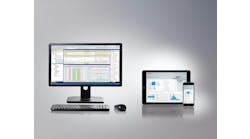Because big data differs from regular data in degree, but not in kind, engineers and other end users are finding ways to take advantage of these new sources of intelligence. Several of these converts described their experiences at the recent Oil & Gas Industry Forum at Automation Fair 2014 in Anaheim, California.
"Where we traditionally used remote terminal units (RTUs) to manage our wells and drilling pads, our construction schedules are so aggressive now and bringing so many wells, controls and I/O into our central control pads that it's no longer efficient to use RTUs only," says C. Kisha Herbert, PE, staff electrical engineer at QEP Resources, an independent crude oil and natural gas exploration and production firm in Denver, Colorado. QEP has 1,000 employees working in eight states. Herbert reports that QEP has built 32 drilling and production facilities since July 2012, each with between 160 and 220 I/O points. To help manage all the new data coming in from its new wells, pads, sensors, controls and other components automatically and quickly, QEP recently adopted ControlLogix PLCs from Rockwell Automation.
See Also: Beautiful Software Brings Meaning and Pleasure to Big Data
"On a typical QEP pad and production facility, well locations are protected through constant monitoring of protective shutdown devices; alarm and event logs review and track specific information and recent events; and standardized ControlLogix PLCs and RSLogix software help us meet our aggressive schedules and maintain safe, standard process controls," explains Herbert. "ControlLogix let the remote I/O points at our remote pads provide useful information to our central control pad. This is easier than using the former RTUs because they require a lot of linear programming to run their loops, routines and subroutines."
Similarly, Nestor Cautiño Ramirez, account manager at ICG Group Automation, reports his system integration firm in Coatzacoalcos, Mexico, has been integrating and optimizing the Dos Bocas TMDB marine oil storage, transportation and distribution terminal for Petroleos Mexicanos (Pemex). The terminal receives heavy Mayan oil from rigs in the Gulf of Mexico, dehydrates and desalts it and then transports it for further refining.
"We use a four-stage process to dehydrate and heat, desalt, residual water treat and residual vapor handle the oil," says Ramirez. "Our project's main goal is ensuring continuous oil transportation throughout these processes, but our existing control system had some issues."
The Dos Bocas terminal had been using ControlLogix CLX 55 PLCs, Flex I/O remote chassis, ControlNet network protocol and RSView 32 HMIs. As a result, Ramirez reports that ICG decided to undertake a phased migration to PlantPAx based on ControlLogix CLX 73 controllers and 1756-SRM2 modules for enhanced redundancy. It also added Ethernet, Foundation fieldbus and Modbus networking.
"These improvements enabled us to achieve our goals for this upgrade project of reducing downtime risks by improving the facility's overall availability and reliability; extending its lifecycle by migrating to current technologies; maximizing the use of its current installed base with the phased migration; complying with applicable regulations; improving the terminal's maintenance and diagnostic capabilities; and reducing the learning curve for its operators and maintainers," says Ramirez. "Not only did we improve the availability and reliability of the terminal's servers, controllers and power supplies, but we also reduced its system recovery time from a full day to just a couple of hours."






